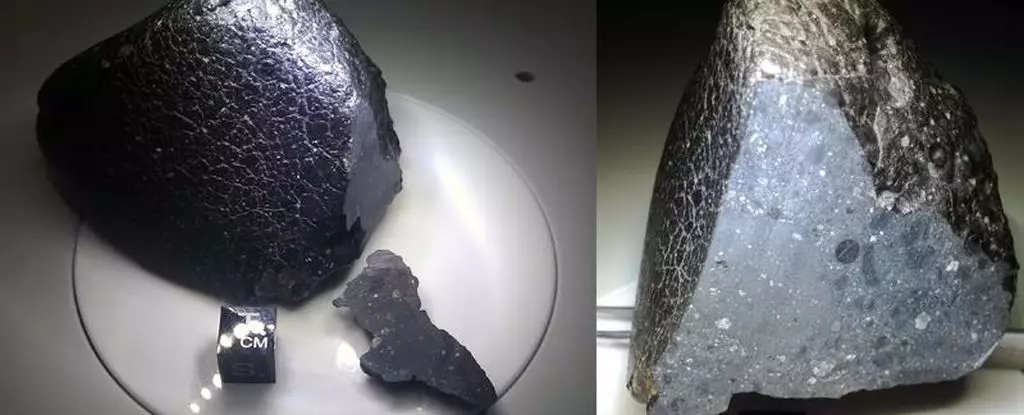The quest to discover whether life ever existed on Mars has been a multidisciplinary endeavor, merging geoscience, astrobiology, and planetary science. Recent findings suggest that Mars was not always the desolate, barren landscape we witness today. Evidence indicates that active water reservoirs may have existed on the Martian surface as far back as 4.45 billion years ago, soon after the planet formed from residual materials of the nascent Sun. The basis for this assertion lies in the discovery of a minuscule zircon crystal embedded in a Martian meteorite, providing a tantalizing glimpse into the planet’s atmospheric and geological history.
The pivotal element in this groundbreaking study was a grain of zircon, measured at less than the thickness of human hair. This crystal is laden with minerals that only form in the presence of liquid water—specifically in heated aqueous environments like hot springs or hydrothermal vents. This remarkable discovery doesn’t merely widen our understanding of Mars; it also establishes intriguing parallels between early Earth and Mars. By analyzing more than just surface materials, scientists are piecing together an intricate planetary narrative that stresses both similarities and disparities in their developmental trajectories.
Geologist Aaron Cavosie from Curtin University emphasizes the importance of this finding. By correlating data from Earth and Mars, he suggests that both planets exhibited water-rich environments around the same epoch, nurturing the prospects for microbial extremophile life. His work hints that both planets bore witness to similar geological conditions, invoking the possibility of ancient life on Mars during a time when Earth’s geological record shows signs of early biotic activity.
The analysis of Mars’ history revolves around various key factors: the form of water, its temperature, and the geological environments that contributed to its formation. The evidence indicates that water on Mars could have existed in hot hydrothermal systems—a finding groundbreaking not only for its implications regarding the Martian climate but also for understanding how similar planetary features may have developed on Earth. Hot volcanic activity likely played a critical role, potentially facilitating water circulation within the planet’s crust.
The study of the Martian meteorite NWA 7034—nicknamed ‘Black Beauty’—unveils more than just mineral compositions; it reveals a complex history marked by geological upheaval. By utilizing nanoscale microscopy, researchers led by Jack Gillespie examined the zircon crystal for trapped elements like iron and sodium, suggesting the involvement of hot aqueous fluids. This morphological layering evokes comparisons to Earth’s Olympic Dam, solidifying the idea that Martian zircons formed under high-temperature conditions conducive to water presence.
While the precise temperature of the water remains speculative, it’s reasonable to suspect it could have been in the range of several hundred degrees Celsius—thriving environments resembling Earth’s geothermal hotspots, such as Yellowstone National Park. Thus, the idea of “soggy” Mars begins to take shape, suggesting that the planet underwent water accumulation through similar planetary processes that formed Earth, including impacts from comets and asteroids.
Speculatively, if this heated water managed to escape to the surface, it could have significantly contributed to Mars’ early atmosphere, generating warm, moist conditions that could foster life. Although definitive evidence of surface water in this early Martian epoch is elusive, the potential historical parallels with Earth’s climatic systems compel further investigation.
As scientists further dissect findings from the NWA 7034 meteorite, questions arise regarding the extent and nature of Mars’ early hydrothermal systems. Was this remarkable environment widespread, or did it represent isolated pockets of habitability? Moreover, are these hydrothermal conditions products of internal geological dynamics or external asteroid impacts?
There exists an exhilarating narrative within the zircon’s survival story, which hints at Mars’ cataclysmic past. After forming in a hydrothermal system, this rock endured repeated meteor strikes that shattered and redistributed its material. Remarkably, through a fortuitous chain of events, it ended up landing on Earth, starkly contrasting its tumultuous journey through space.
Unraveling the mysteries surrounding water on Mars not only intensifies the narrative of planetary evolution but also fuels the intrigue surrounding the potential for extraterrestrial life. As researchers continue to analyze Martian specimens like the ‘Black Beauty’ meteorite, we inch closer to understanding our solar system’s shared history and the environmental conditions that may have once thrived on the surface of Mars. In a universe characterized by endless complexities, the quest for knowledge continues—fueling excitement about what the future holds for space exploration.


Leave a Reply